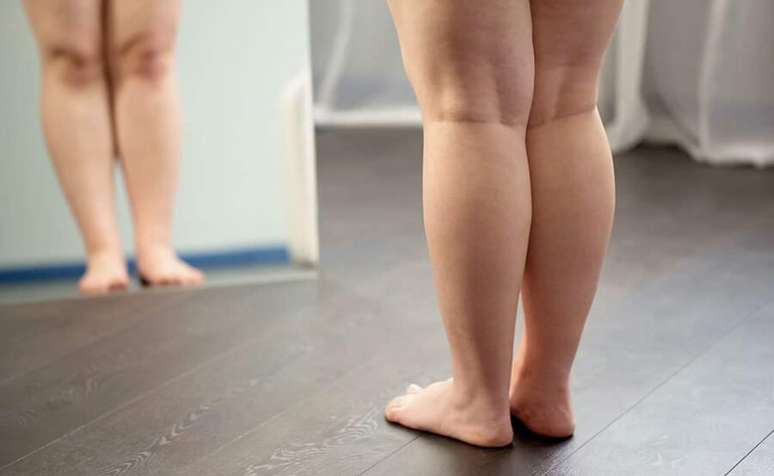If left untreated, lipedema can reduce mobility in the knee region and accelerate degeneration of the joint.
After being standardized as a disease in 2022, lipedema has gained greater recognition, but today it still tends to be overlooked by doctors and patients, delaying diagnosis and treatment and resulting in a worsening of the condition, which can also lead to orthopedic knee problems.
“Lipedema is characterized by the abnormal accumulation of adipose tissue with a disproportionate increase in size, mainly in the legs and hips. This fat accumulation can cause significant limitation of the knee’s range of motion, which is measured in degrees. For example, while a person without lipedema has a knee range of motion of up to 140°, individuals affected by this pathology can reduce it to 90°,” explains Marcos Cortelazo, orthopedist specializing in knee and sports traumatology, member of the Federation Brazilian Society of Orthopedics and Traumatology (SBOT).
And the damage this condition can cause to knee health isn’t limited to reduced mobility in the region.
“The presence of excess adipose tissue in the inner thigh can cause overload of the knee, putting pressure on the medial compartment of this joint. This increase in pressure leads to accelerated degeneration of the knee joint, which may eventually require surgery to place a prosthesis in the region, a procedure known as arthroplasty,” says the doctor.
He emphasizes that, in the case of lipedema, it is essential that the condition is treated before replacing the knee joint with prosthetics.
“If knee arthroplasty is performed without adequate treatment of fatty tissue, mobility problems caused by lipedema will persist and degeneration of the joint may continue to occur,” emphasizes the specialist.
Evolution of treatment
Aline Lamaita, vascular surgeon and member of the Brazilian Society of Angiology and Vascular Surgery, says that the treatment of lipedema has evolved a lot and, today, there are effective approaches.
“Despite being a chronic disease, meaning there is no cure, lipedema can be controlled if addressed correctly. And today we have an effective line of treatment in this sense that involves a multidisciplinary team made up of a vascular surgeon, a nutritionist, a physiotherapist and, finally, an orthopedist and a plastic surgeon,” says Aline.
“It is very important to emphasize that the treatment of lipedema is not limited to liposuction surgery to remove fat. This is just one of the pillars for controlling the disease, which in some phases is truly fundamental, significantly improving the patient’s quality of life. But clinical treatment must be carried out before and after, in any case, with medications and with the use of compression stockings. Furthermore, changes in lifestyle are also essential to modulate the inflammatory state, with the adoption of an anti-inflammatory diet and regular physical activity”, highlights the specialist.
A case for arthroplasty
It is not uncommon for lipedema treatment alone to be sufficient to reduce knee pain and mobility problems. But, once the condition is under control, your doctor may recommend arthroplasty if necessary.
“The goal of arthroplasty is to replace the worn joint with a knee prosthesis, which can be made of different materials, such as metal and polyethylene, a type of plastic,” says Marcos Cortelazo.
He points out that today there are prosthetics tailored to each patient based on computed tomography images that allow the doctor to analyze the size, shape and position of the knee bones, thus ensuring a perfect fit.
“This means that the surgery is faster, there is less need for bone cuts and the prosthesis can be positioned more easily,” underlines the orthopedist.
Custom knee replacements are indicated in most cases where total arthroplasty is necessary. “However, patients who already have bone loss or severe deformities may not be eligible. It then becomes even more important that patients do not postpone arthroplasty surgery so that the deformities do not worsen, thus making it impossible to use this innovative technology,” he adds.
Finally, it is important to underline that even in the case of lipedema, early diagnosis and treatment are essential to prevent the problem from worsening.
“In addition to motor difficulties and orthopedic knee problems, lipedema, if not treated, can lead to the onset of pathologies such as lymphedema and circulatory dysfunctions, such as venous insufficiency. It is therefore important to pay attention to the symptoms of the disease, which include a symmetrical increase in the size of the limbs, especially of the legs and hips, although in a smaller number of cases it also affects the arms; difficulty losing weight, especially in the lower body; painful sensation to touch; increased frequency of spontaneous hematomas; and a greater tendency to accumulate liquids”, concludes Aline Lamaita.
inspires transformation in the world of work, in business, in society. Compasso, a content and connection agency, is born.
Source: Terra
Ben Stock is a lifestyle journalist and author at Gossipify. He writes about topics such as health, wellness, travel, food and home decor. He provides practical advice and inspiration to improve well-being, keeps readers up to date with latest lifestyle news and trends, known for his engaging writing style, in-depth analysis and unique perspectives.







![A Better Life Preview: What’s in store for Friday, October 24, 2025 Episode 449 [SPOILERS] A Better Life Preview: What’s in store for Friday, October 24, 2025 Episode 449 [SPOILERS]](https://fr.web.img6.acsta.net/img/16/27/1627e795b389773da60b2ef0a5dfdfd0.jpg)
